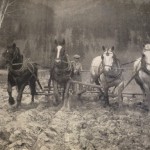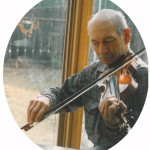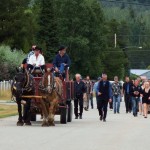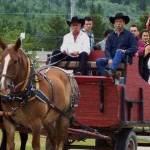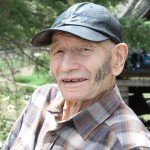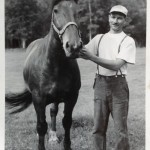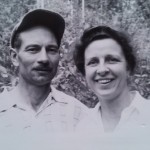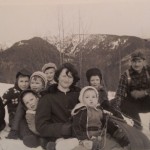By: Korie Marshall
When you live in a remote place like the Canoe and Robson Valley, especially in the early 1900’s you learned to look after yourself and take care of your own.
For Jim McKirdy, his own seems to be the entire community, and his ethic, self-reliance and generosity is reflected in that community. Jim passed away July 22nd, just a week after his 94th birthday, but his stories live on through his extended family and the entire community.
If you’ve been in Valemount long enough, you’ve probably heard the story of the guy climbing a cable across the North Thompson, because the cable car was tied to the other side. That was Jim. One of his daughters, Florence (Flossie) Smith told the story in her eulogy, of how her dad was escorting her and a group, mostly teenagers, to visit Betty French who lived on the non-highway side of the North Thompson River. To get there, you used a cable car, but this time, it was on the wrong side of the river. Flossie says with no hesitation, Jim grabbed the cable and monkey-climbed across, while she watched the rough waters and rocky banks of the North Thompson some 50 feet below, to untie the car and bring it back. She says he was tenacious, with amazing physical endurance, and he was either unaware or did not consider the risks of many situations – he just saw it had to be done.
Flossie says Jim’s generosity was synergized by his wife Doris’ sense of hospitality. “They had an innate sense that any talents, good fortune or property that was in their possession was there to benefit all,” she says, and they welcomed everyone into their home.
Jim was the eldest son of Fulton and Margaret McKirdy. Fulton was one of the first white settlers in Valemount. As a child Jim helped on the family farm and spent time with his father on the trapline, learning skills like river boating, trapping and handling a canoe. He was mechanically gifted, and Flossie says her dad became a driver and mechanic at age 12, when Fulton brought one of the first motorized vehicles to the valley. Jim trained as an aircraft mechanic for the Armed Forces during World War II; drove a lumber truck in the 1950’s; worked for Canyon Creek Sawmills in the late 1960’s; and was involved in his own and a number of other small-scale lumber mills and logging operations through the years. Flossie says he also worked on the construction of Highway 5 in the 1970’s, worked for BC Hydro in the 1980’s, and did the snow survey for Environment Canada for many decades.
Flossie says Jim worked hard, but made room for recreation and fun. The family often went on Sunday outings of picnics, hiking, trips to the hot springs and berry picking, and Flossie says Jim made several tools for recreation, like snowshoes made of wood and rawhide; a metal bob sled, welded from pipes that withstood at least three decades of children’s winter fun; and a bow and arrow that Flossie got when she was eight.
In another eulogy, Jim’s son-in-law Gordon Carson says he first met Jim in 1968 when he came to work at Canyon Creek.
“At first, Jim was the guy who hung out in the Chip N’ Saw room and said “suffering cats” all the time. But one day he stopped me after work and said ‘I hear you play music. Why don’t you come over and bring your accordion?’”
Soon Gordon was renting a room for $50 a month on the condition he had no wild parties, and sharing supper with the family, since Doris decided he needed at least one good meal a day. Gordon says at first he felt like he was imposing on them, but “after seeing all the people that rotated in and out of their home, always welcomed and fed and put to work, I realized they viewed everyone as an asset to their family.”
A few years later, Gordon says he and Jim decided to set up a mill on Jim’s place, and he cleared the site while Jim worked on a 1942 forklift with no motor he got from Ed Landry.
“True to his nature, every detail had to be just right,” says Gordon, “and anything that could be recycled from the scrap iron pile or rebuilt was worth way more than any new part.” He says it took Jim five months to finish the forklift, and five years for him to let Gordon drive it.
“Forty years later it is still running and after all that time with Jim it’s amply infused with bits of his character,” Gordon says. “It was always slow but very dependable. It could do a lot of jobs that others couldn’t. Like Jim, it didn’t steer too well. When the road got rough, it played music. It slowed down in cold weather, but it always got going. In the past couple of years it missed a bit, but Jim wasn’t quite firing on all cylinders either.”
Jim’s dementia had become more apparent recently, but his sense of self-reliance – and that which he had passed to his family – was not diminished. After his passing, the family wanted to have a burial without the services of an undertaker. His daughter Ann says it’s a way for the family to “look after our own deceased,” but it is also a tribute to a patriarch who was both self-reliant and giving. After the funeral mass, Jim’s body was carried to the cemetery in a horse drawn wagon followed by family and loved-ones on foot. Therese McKirdy, Jim’s daughter-in-law, says after the service a gathering of singers, guitar, banjo, fiddle, piano, and harmonica players resounded through the family residence well into the wee hours after midnight, a fitting tribute to a man who loved music, family and community.



